

Heat Stress
Heat stress in dairy cattle occurs when a cow’s heat load is higher than her capacity to lose heat, leading to reduced animal welfare and—in extreme cases—death.
Heat stress effects on fertility include:
- An increase in the number of open days.
- Reduced conception rate, ranging between 20% and 30% compared to the results obtained in the winter months1,2.
- More cows suffering various types of anestrus.
- Decreased reproductive success because of potential direct effects on the ovaries, uterus, gametes, embryos and early fetus.
Heat stress disrupts reproduction in two general ways3:
- Physiological adjustments: redistribution of blood flow and energy deficits.
- Elevated internal body temperature directly disrupts endocrine mechanisms and cellular physiology (ovarian cells, germ cells, embryo or other).
Impact of heat stress on endocrine mechanisms:
- It reduces LH levels in cows, which interferes with maturation and ovulation of dominant follicles.
- GnRH is depressed and FSH is elevated during heat stress.
- Follicular estradiol secretion is depressed during heat stress, which disrupts expression of estrus, gonadotropin surge, ovulation, transport of gametes and fertilization.
- In case dominant follicles ovulate, subsequent plasma progesterone concentrations are reduced, which limit endometrial function and embryo development.
In high-producing dairy animals with high metabolic demands, these effects are exacerbated4.
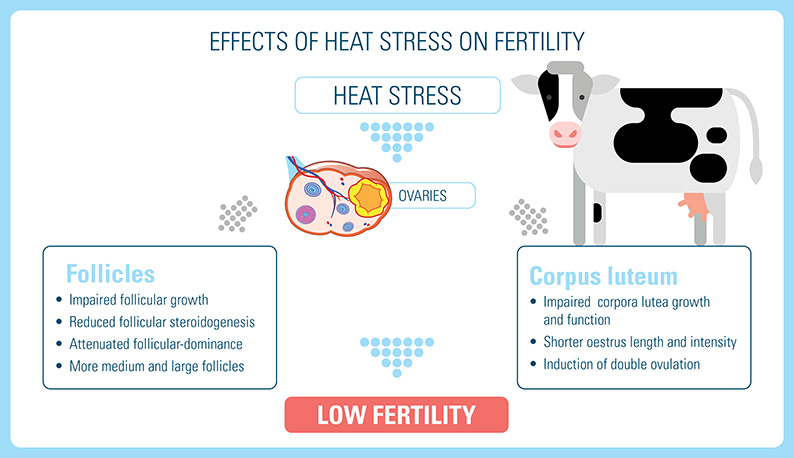
The bovine thermal comfort zone ranges from 5°C to 25°C, and 80% their body temperature ranges from 38.4°C to 39.1°C5. Heat stress is a combination of temperature and humidity. Above 25°C and 80% relative humidity, cows suffer from heat stress, diminishing their health status and zootechnical performance.
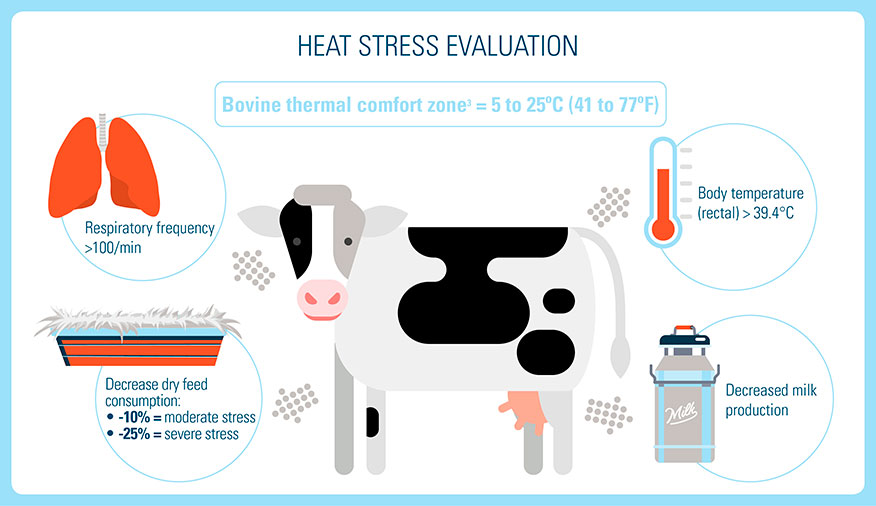
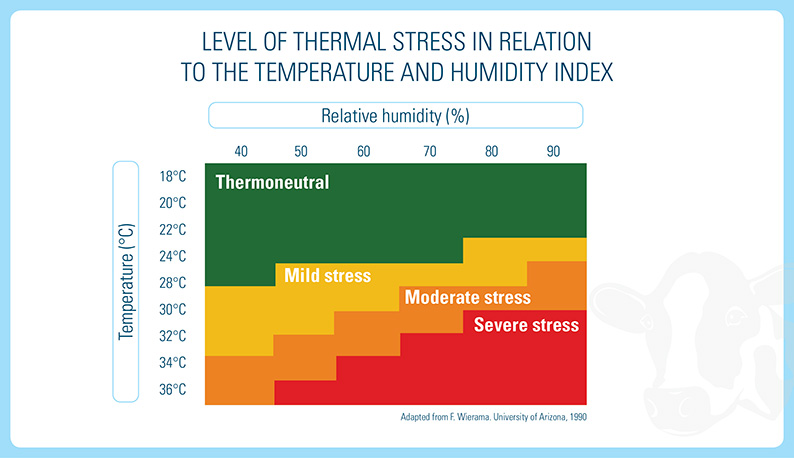
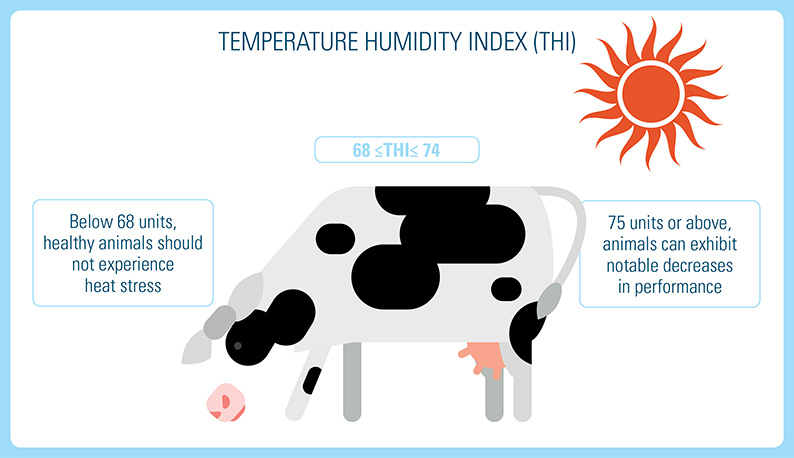
Heat stress acts in more than one way to reduce fertility in lactating dairy cows:
- Indirectly, by reducing dry feed intake, which inhibits gonadotropin-releasing hormone (GnRH) and luteinising hormone (LH) secretion from the hypothalamic-pituitary system.
- Directly, by compromising the uterine environment, causing embryo loss and infertility.
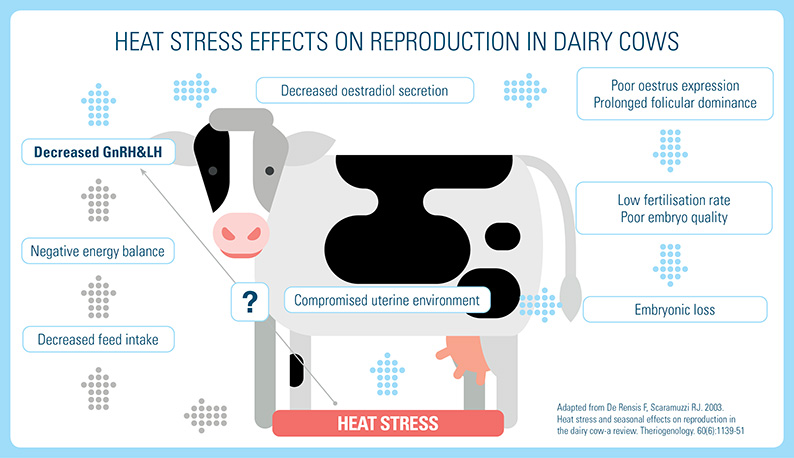
Effect on the Reproductive Pattern
- Reduced duration and intensity of estrus.
- Decreased mounting and other manifestations of estrus.
- Holstein cows are mounted 4.5 times per estrus during the summer versus 8.6 times per estrus in winter6.
Effect on Embryo Quality and Development
- Gamete-formation is temperature sensitive. Plasma LH concentrations are lower in cows exposed to high ambient temperatures.
- Disrupting the follicle and its enclosed oocyte seem to be pivotal in the complex mechanisms that impair fertility due to heat stress2.
- Adverse effects of heat stress appear during the period from oocyte maturation to preimplantation development.
- Most detrimental effects of heat stress could be the result of oxidative stress caused by the temperature elevation:
- Direct damage to organelles or induced DNA damage (leading to apoptosis)
- Altered gene expression
- Reduced developmental competence in preimplantation embryos

Semen Quality
Hyperthermia of the scrotum and testes can lead to poor morphological and functional semen quality, thus causing deterioration in bull fertility.
Uterine Environment
Heat stress may decrease flow of blood to the uterine environment. Exposure to high temperatures during pregnancy may cause blood to be diverted from some organs, such as the uterus, to others involved in heat regulation, such as the skin, lungs and respiratory tract.
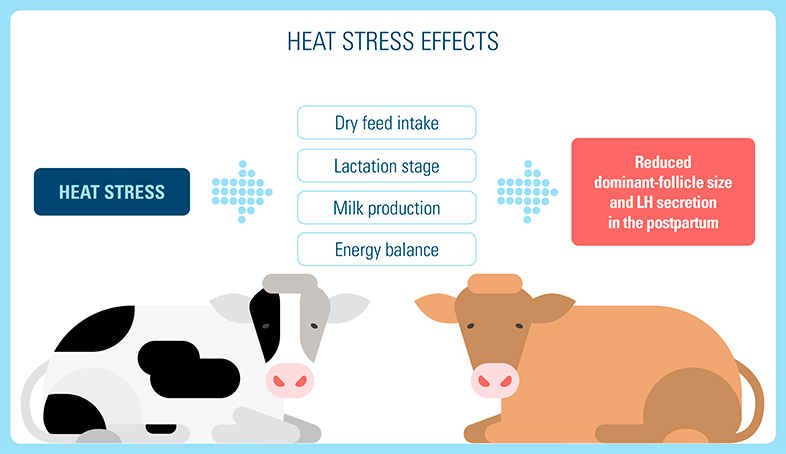
Prolonged negative energy balance is one of the main causes of anovulation in dairy cows, especially early post partum7. Reduced feed intake results in:
- Poor follicular development
- Low estrus LH expression
- Poor oocyte quality2
Three Main Strategies
- Biotechnical Options
Genetically Develop More Heat-Tolerant Dairy Breeds
This can improve both the reproductive ability and adaptability of cows to warmer climates8.
Embryo Transfer
This can bypass the harmful effects heat stress has on the fertility of lactating dairy cows9.
- Management
Nutritional Modification
Decreased feed intake in heat-stressed cows causes a negative energy balance. Also, the energy requirements of heat-stressed cows are higher, because their core body temperature is increased and their heat-dissipation processes are inefficient.
Feeding these animals high-quality forage supplemented with concentrates, additional fats and feed additives can help mitigate some of these adverse effects10.
More fiber and/or fewer concentrates in the ration will increase rumination, and this will compensate for rumen and metabolic acidosis. You can also provide bi-carbonate in the ration to compensate the rumen acidosis.
Environmental Modification
Shade protects from direct solar radiation but does not alter the air temperature or the relative humidity of their surroundings.
Evaporative cooling strategies are costly, but are very useful for alleviating heat stress in animals. Lack of proper ventilation can lead to high moisture levels, manure gases, pathogens and dust concentrations, creating an adverse environment for dairy cows.
However, the selection of cooling systems to improve cow health and performance may vary between humid and arid areas. Options should optimize the combination of increased air velocity and conductive cooling to improve cow well-being by reduce their body temperature11.
- Hormonal Therapy
Hormonal therapy does not address the causes of heat stress, but it can ameliorate some of its direct effects on the endocrine reproductive axis. It can also help to overcome the decrease in reproductive performance in cattle seen during summer and early autumn.
Timed Artificial Insemination (TAI) Protocol
Breeding synchronization protocols for insemination at fixed time-points may reduce the calving-conception interval and the number of services per conception.
The optimal hormone treatment to combat the effects of heat stress should:
- Be suitable for cows in a fixed time-point insemination program and avoid the need for heat detection.
- Resolve anoestrus, including ovarian cysts or anovulatory follicles.
- Have a short duration.
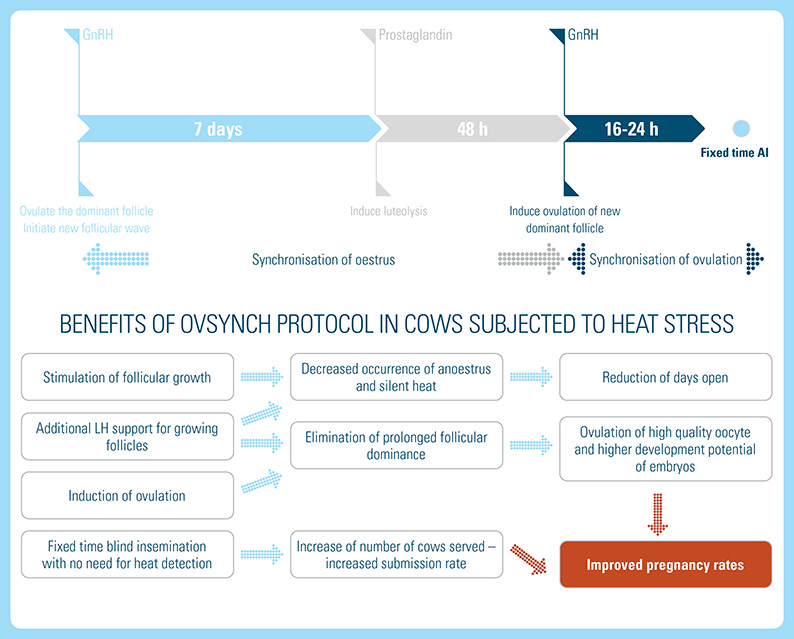
One of the most popular treatments, the OvSynch protocol, consists of the following treatments: GnRH (day 0), prostaglandin F2α (day 7), and GnRH (day 9), with artificial insemination 16-20 hours after the second GnRH treatment. It has been shown that TAI protocol can reduce losses in reproductive efficiency in cattle caused by poor summer estrus detection.
GnRH Administration at Estrus
Induction of ovulation with GnRH not only decreases the incidence of delayed ovulation, but also provides additional luteotrophic support to the early corpus luteum.
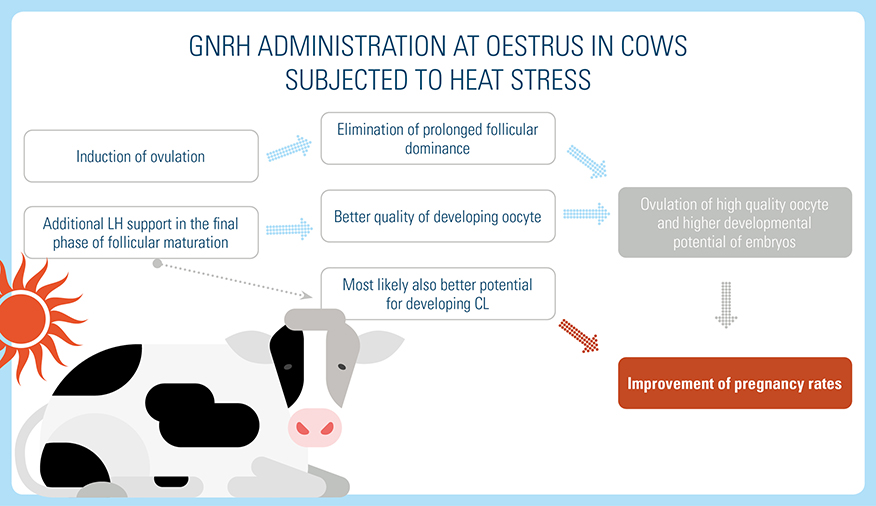
GnRH or Human Chorionic Gonadotropin (hCG) Administration Post Artificial Insemination
Administration of hCG or GnRH post insemination supports the function of the yellow body in the ovary, thereby maintaining higher progesteron levels resulting in higher pregnancy rates.
- Wolfenson, D., Roth, Z., Meidan, R. 2000. Impaired reproduction in heat-stressed cattle: basic and applied aspects. Review. Anim Reprod Sci. 60-61:535-47.
- De Rensis, F., Scaramuzzi, R.J. 2003. Heat stress and seasonal effects on reproduction in the dairy cow–a review. Theriogenology. 60(6):1139-51.
- Wakayo, B.U., Brar, P.S., Prabhakar, S. 2015.Review on mechanisms of dairy summer infertility and implications for hormonal intervention. Open Veterinary Journal. 5(1):6-10.
- De Rensis, F., Garcia-Ispierto, I., López-Gatius, F. 2015. Review: Seasonal heat stress: Clinical implications and hormone treatments for the fertility of dairy cows. Theriogenology 84: 659-666.
- National Research Council. Effect of environment on nutrient requirements of domestic animals. Washington DC: National Academy Press; 1981. p.75-84.
- F. J. White, R. P. Wettemann, M. L. Looper, T. M. Prado, G. L. Morgan, Seasonal effects on estrous behavior and time of ovulation in nonlactating beef cows, Journal of Animal Science, Volume 80, Issue 12, December 2002, Pages 3053–3059.
- Butler, W. (2005). Nutrition, negative energy balance and fertility in the postpartum dairy cow. Cattle Practice. 13. 13-18.
- Soumya Dash, A.K., Chakravarty, A.S., Arpan, U., Manvendra, S., Saleem, Y. 2016. Effect of heat stress on reproductive performances of dairy cattle and buffaloes: A review. Vet World. 9(3): 235-244.
- Al Katanami, Y.M., Drost, M., Monson, R.L., Rutledge, J.J., Krininger III, C.E., Block, J. 2002. Pregnancy rates following timed embryo transfer with fresh or vitrifed in vitro produced embryos in lactating dairy cows under heat stress condition. Theriogenology 58:171-82.10.
- Godara, Asu & Bhat, Showkat & Yogi, Ravindra & Devi, Sunitibala & Sahoo, Sarada. (2016). Feeding strategies to ameliorating the impact of heat stress in bovine. 7. 25-29.
- Fournel S, Ouellet v, Charbonneau É. (2017). Practices for Alleviating Heat Stress of Dairy Cows in Humid Continental Climates: A Literature Review. Animals, 7(5), 37.

